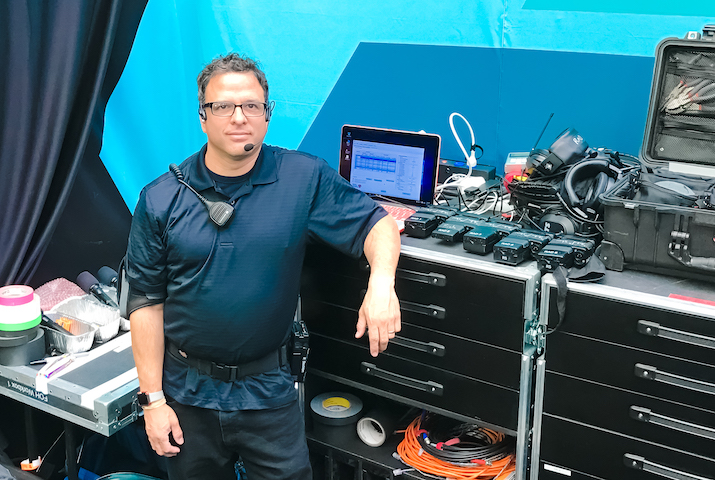RF Audio for Concacaf Gold Cup Requires Frequencies That Play Well Together
It’s more than just assigning frequencies, particularly with roving mics
Story Highlights
When Mexico won its record ninth Concacaf Gold Cup, beating Panama 1-0, on July 16, much of what was heard from the broadcasters’ (Fox Sports/Tubi in English, TUDN/ViX in Spanish) four roving wireless microphones had to jump through a few hoops to get through the PA system at SoFi Stadium and on the air clearly.
“The goal is to put your mics in the best channels, the cleanest channels, and sometimes the options you create get to the event frequency coordinator, and sometimes they don’t,” says Richard Stockton, a freelance RF engineer who works the SoFi venue often at certain events.

RF engineer Richard Stockton: “You can get a good [frequency], but, if you don’t walk it around, you won’t know where all the problems are hiding.”
Good RF Neighbors
“It’s not just about assigning different [frequencies],” he explains. “It’s about going through them and dissecting the numbers to make sure that, when transmitters get physically in close proximity, no harmonics or RF spectrum noise is created. That’s what people overlook the most. They think that you could just assign different frequencies, but they don’t realize what happens when I walk them within 2 ft. of each other.”
What happens is intermodulation distortion (IMD), which can impair a broadcast’s audio, creating speech-intelligibility and drop-out issues.
“Intermodulation distortion basically occurs when you turn on or energize transmitters, and a lot of people overlook it,” says Stockton, who used a spectrum analyzer to identify the problem and point it out to the frequency coordinator even after getting a new RF channel. “Before the game, the analyzer showed two harmonics popping up right next to that new frequency. It’s maybe just 20 kHz away, but it’s enough that it can cause problems. A picture is worth a thousand words at that point, and, as soon as they see it [on a screen], they believe you.”
Walk It Around
Although an analyzer display can get you fairly far along the road to clean wireless, at some point, you have to move the transmitters around — as sideline reporters with their mics will be doing during the game — to make sure that the frequencies will get along everywhere in the venue.
“I can’t emphasize enough,” Stockton says, “that you can get a good [frequency] but, if you don’t walk it around and see how it interacts [with other frequencies], you won’t know where all the problems are hiding. Sometimes, it’s the building’s reflections that interfere with the RF. It might happen in one part but not another. You have to walk the transmitters everywhere the microphones are supposed to go.”
(At the Concacaf Gold Cup, the talent, having already started their main rehearsal, walked the transmitters around for Stockton.)
Like most soccer matches, the Concacaf Gold Cup covers a lot of ground, which he says ruled out the use of diversity antennas in multiple smaller spaces or two split A and B zones. Instead, he deployed Shure’s AD4Q-US Axient Digital four-channel wireless system. Its Quadversity mode configures the receiver to accept four antenna inputs to maximize RF coverage to minimize the risk of dropouts and signal loss caused by interference. It also allows users to place two pairs of antennas to cover different zones.
“Quadversity gives me more RF headroom when signal-to-noise is not ideal,” Stockton explains. “That means you can have more-consistent–quality audio, walk farther away from your receiver, and still have more-stable RF in general. This is huge when you are given less-than-ideal RF frequencies to work with and in a crowded spectrum like in Los Angeles. It also allows users to place four discrete A,B,C and D antennas to cover one large zone.”
It also helped, he adds, that it was Axient’s digital iteration, which allows frequencies to be operated closer together than in an analog domain.
Preparation and a Plan B
Although much of the frequency coordination task takes place weeks ahead of events and from anywhere you can set up a laptop and get Wi-Fi, managing RF at the venue is just as critical and often more intense. Stockton stays on guard for things like two-way radios and other crews’ transmitters suddenly turning on and has a Plan B for when they do. (In this case, Plan B would have been to go to the guard bands in the 614-617 MHz range and address the concomitant lower output power. Fortunately, it wasn’t necessary.)
“A lot of the job of the RF tech is to sit there in front of your screens and make sure things are where they’re supposed to be, especially before a kickoff,” he says. “Three hours before a kickoff, you’re sitting there, looking at the spectrum analyzer and at [Shure’s RF spectrum-management toolset Wireless] Workbench and making sure nothing pops up as noise.”
Some of that job meets neither the ear nor the eye: Stockton had to manually troubleshoot what turned out to be a single troublesome fiber connection between the antennas and the receiver, a task that took nearly three hours.
The one saving grace? “It was just the four RF channels for the event. At a typical NFL game at SoFi, there’s at least 20-30 for your setup and 200 or more for everyone as a whole.”
